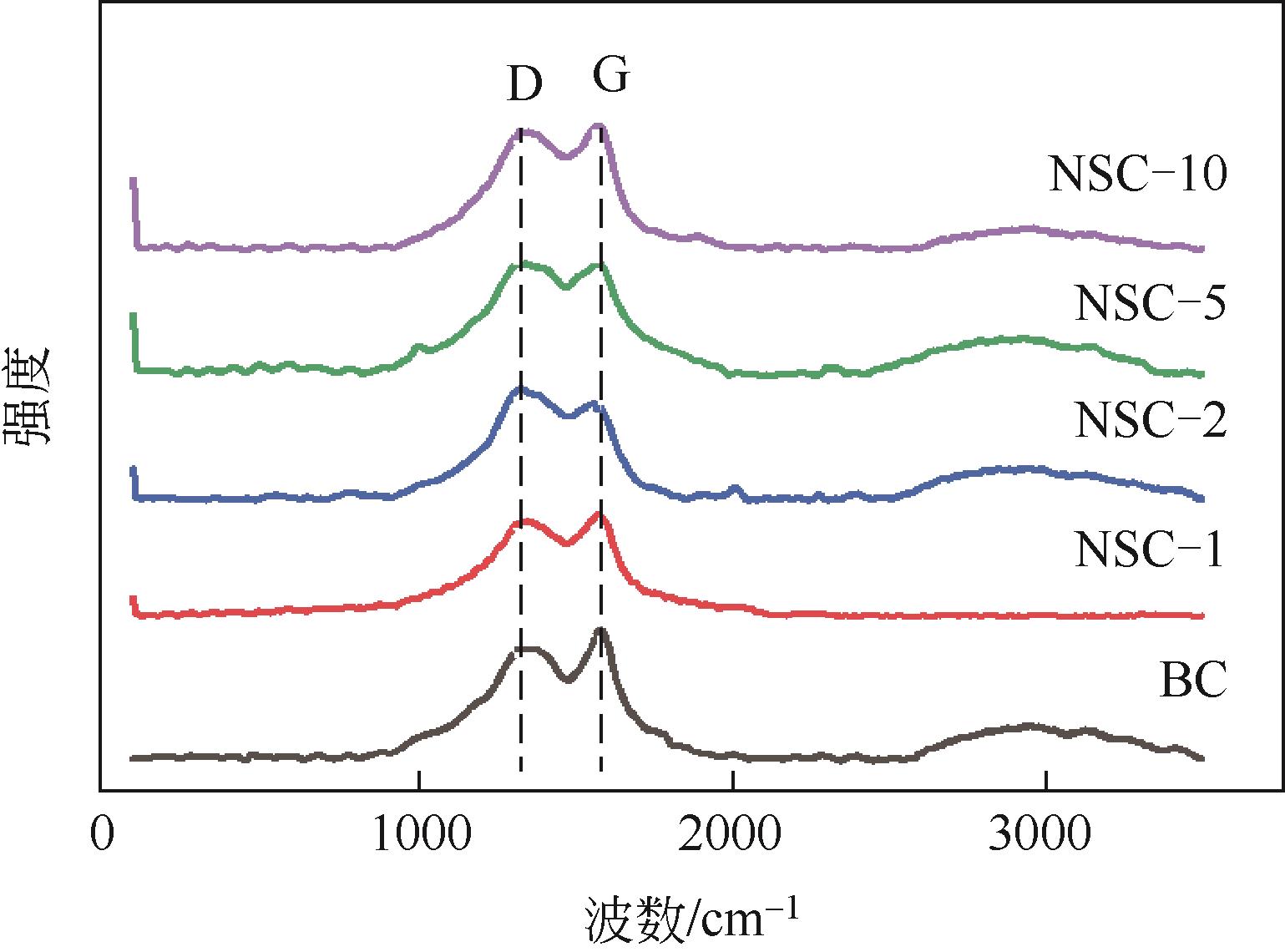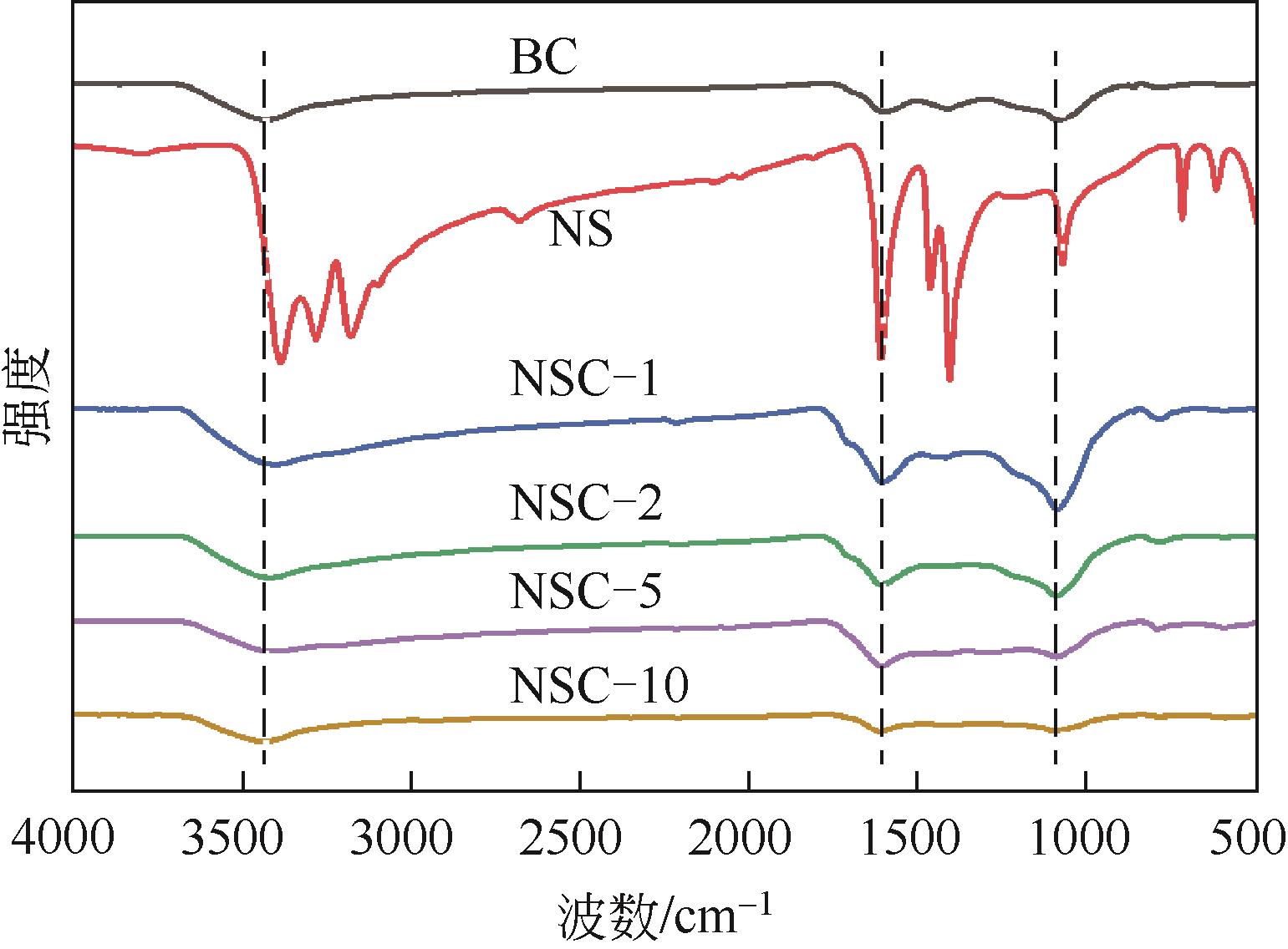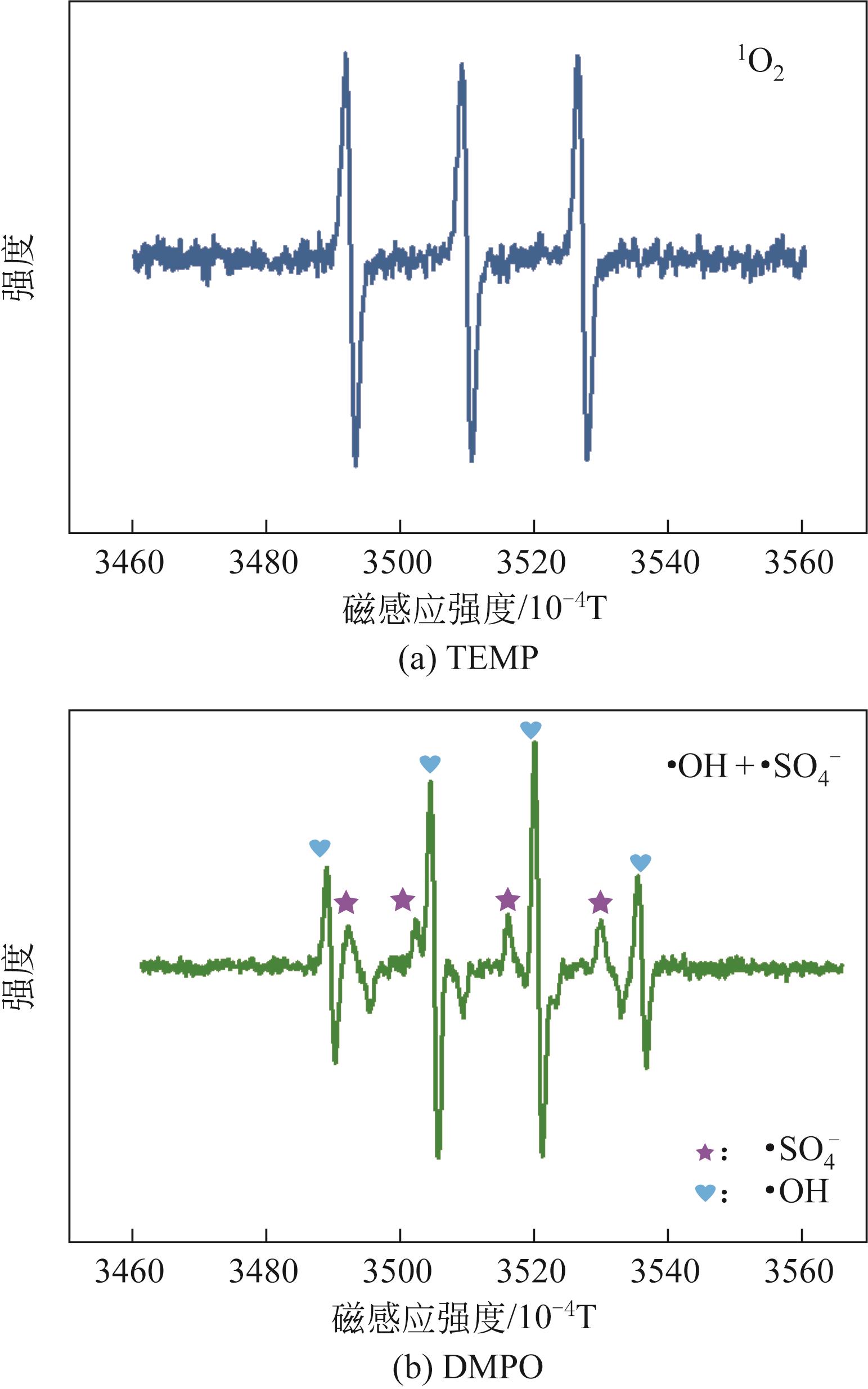Chemical Industry and Engineering Progress ›› 2022, Vol. 41 ›› Issue (8): 4204-4212.DOI: 10.16085/j.issn.1000-6613.2021-2197
• Industrial catalysis • Previous Articles Next Articles
Nitrogen-sulfur doped biochar/permonosulfate for degradation of sulfisoxazole in water
PAN Jie1( ), WANG Mingxin1, GAO Shengwang2(
), WANG Mingxin1, GAO Shengwang2( ), XIA Xunfeng2, HAN Xue2
), XIA Xunfeng2, HAN Xue2
- 1.College of Environmental and Safety Engineering, Changzhou University, Changzhou 213164, Jiangsu, China
2.Chinese Research Academy of Environmental Sciences, Beijing 100012, China
-
Received:2021-10-27Revised:2022-03-13Online:2022-08-22Published:2022-08-25 -
Contact:GAO Shengwang
氮硫掺杂生物炭/过一硫酸盐体系降解水中磺胺异 唑
唑
潘杰1( ), 王明新1, 高生旺2(
), 王明新1, 高生旺2( ), 夏训峰2, 韩雪2
), 夏训峰2, 韩雪2
- 1.常州大学环境与安全工程学院,江苏 常州 213164
2.中国环境科学研究院,北京 100012
-
通讯作者:高生旺 -
作者简介:潘杰(1997—),女,硕士研究生,研究方向为水污染控制。E-mail:526313107@qq.com 。 -
基金资助:国家重点研发计划(2019YFD1100201)
CLC Number:
Cite this article
PAN Jie, WANG Mingxin, GAO Shengwang, XIA Xunfeng, HAN Xue. Nitrogen-sulfur doped biochar/permonosulfate for degradation of sulfisoxazole in water[J]. Chemical Industry and Engineering Progress, 2022, 41(8): 4204-4212.
潘杰, 王明新, 高生旺, 夏训峰, 韩雪. 氮硫掺杂生物炭/过一硫酸盐体系降解水中磺胺异 唑[J]. 化工进展, 2022, 41(8): 4204-4212.
唑[J]. 化工进展, 2022, 41(8): 4204-4212.
share this article
Add to citation manager EndNote|Ris|BibTeX
URL: https://hgjz.cip.com.cn/EN/10.16085/j.issn.1000-6613.2021-2197
| 1 | 朱洁, 孟香港. 抗生素在我国水生环境中的研究进展[J]. 科技风, 2019(34): 119-120. |
| ZHU Jie, MENG Xianggang. Research progress of antibiotics in aquatic environment in my country[J]. Technology Wind, 2019(34): 119-120. | |
| 2 | 李秀文, 何益得, 张巍, 等. 磺胺类抗生素对水环境的污染及生态毒理效应[J]. 环境科学与技术, 2018, 41(S1): 62-67. |
| LI Xiuwen, HE Yide, ZHANG Wei, et al. Pollution status of sulfonamides in aquatic environment and its ecotoxicological effects on aquatic organisms[J]. Environmental Science & Technology, 2018, 41(S1): 62-67. | |
| 3 | 颜平平, 隋倩, 吕树光, 等. 二价铁活化过碳酸钠对磺胺甲𫫇唑的去除[J]. 化工进展, 2018, 37(9): 3635-3639. |
| YAN Pingping, SUI Qian, Shuguang LYU, et al. Removal of sulfamethoxazole by ferrous-activated sodium percarbonate in the aqueous phase[J]. Chemical Industry and Engineering Progress, 2018, 37(9): 3635-3639. | |
| 4 | 刘一清, 苏冰琴, 陶艳, 等. 磁性纳米Fe3O4活化过硫酸盐降解水中磺胺甲𫫇唑[J]. 环境工程学报, 2020, 14(9): 2515-2526. |
| LIU Yiqing, SU Bingqin, TAO Yan, et al. Degradation of sulfamethoxazole in water by magnetic nano-Fe3O4 activated persulfate[J]. Chinese Journal of Environmental Engineering, 2020, 14(9): 2515-2526. | |
| 5 | 李峰, 刘桂芳, 梁涛, 等. Fe2+/NH2OH联合活化过硫酸盐降解水中磺胺甲𫫇唑[J]. 高校化学工程学报, 2017, 31(5): 1210-1216. |
| LI Feng, LIU Guifang, LIANG Tao, et al. Degradation of sulfamethoxazole in aqueous solution by ferrous/hydroxylamine activated peroxymonosulfate[J]. Journal of Chemical Engineering of Chinese Universities, 2017, 31(5): 1210-1216. | |
| 6 | GHANBARI F, MORADI M. Application of peroxymonosulfate and its activation methods for degradation of environmental organic pollutants: review[J]. Chemical Engineering Journal, 2017, 310: 41-62. |
| 7 | ANIPSITAKIS G P, DIONYSIOU D D. Degradation of organic contaminants in water with sulfate radicals generated by the conjunction of peroxymonosulfate with cobalt[J]. Environmental Science & Technology, 2003, 37(20): 4790-4797. |
| 8 | GHAUCH A, TUQAN A M. Oxidation of bisoprolol in heated persulfate/H2O systems: kinetics and products[J]. Chemical Engineering Journal, 2012, 183: 162-171. |
| 9 | QI C D, LIU X T, MA J, et al. Activation of peroxymonosulfate by base: implications for the degradation of organic pollutants[J]. Chemosphere, 2016, 151: 280-288. |
| 10 | GUO H G, GAO N Y, YANG Y, et al. Kinetics and transformation pathways on oxidation of fluoroquinolones with thermally activated persulfate[J]. Chemical Engineering Journal, 2016, 292: 82-91. |
| 11 | LIU J, ZHOU J H, DING Z X, et al. Ultrasound irritation enhanced heterogeneous activation of peroxymonosulfate with Fe3O4 for degradation of azo dye[J]. Ultrasonics Sonochemistry, 2017, 34: 953-959. |
| 12 | SHARMA J, MISHRA I M, DIONYSIOU D D, et al. Oxidative removal of bisphenol A by UV-C/peroxymonosulfate (PMS): kinetics, influence of co-existing chemicals and degradation pathway[J]. Chemical Engineering Journal, 2015, 276: 193-204. |
| 13 | ANIPSITAKIS G P, DIONYSIOU D D. Radical generation by the interaction of transition metals with common oxidants[J]. Environmental Science & Technology, 2004, 38(13): 3705-3712. |
| 14 | LIU H, SUN P, FENG M B, et al. Nitrogen and sulfur co-doped CNT-COOH as an efficient metal-free catalyst for the degradation of UV filter BP-4 based on sulfate radicals[J]. Applied Catalysis B: Environmental, 2016, 187: 1-10. |
| 15 | 王郑, 王佳豪, 田湉, 等. 改性活化过硫酸盐应用及机理研究进展[J]. 精细化工, 2021, 38(7): 1305-1313. |
| WANG Zheng, WANG Jiahao, TIAN Tian, et al. Research progress on the application and mechanism of modified biochar activated persulfate[J]. Fine Chemicals, 2021, 38(7): 1305-1313. | |
| 16 | LIU Z, ZHANG L H, SHENG L Z, et al. Edge-nitrogen-rich carbon dots pillared graphene blocks with ultrahigh volumetric/gravimetric capacities and ultralong life for sodium-ion storage[J]. Advanced Energy Materials, 2018, 8(30): 1802042. |
| 17 | ZHU S S, HUANG X C, MA F, et al. Catalytic removal of aqueous contaminants on N-doped graphitic biochars: inherent roles of adsorption and nonradical mechanisms[J]. Environmental Science & Technology, 2018, 52(15): 8649-8658. |
| 18 | JIANG J J, WANG X Y, YUE C L, et al. Nitrogen vacancies induce sustainable redox of iron-cobalt bimetals for efficient peroxymonosulfate activation: dual-path electron transfer[J]. Chemical Engineering Journal, 2022, 427: 131702. |
| 19 | CHEN X, DUAN X G, OH W D, et al. Insights into nitrogen and boron-co-doped graphene toward high-performance peroxymonosulfate activation: maneuverable N-B bonding configurations and oxidation pathways[J]. Applied Catalysis B: Environmental, 2019, 253: 419-432. |
| 20 | BAG S, MONDAL B, DAS A K, et al. Nitrogen and sulfur dual-doped reduced graphene oxide: synergistic effect of dopants towards oxygen reduction reaction[J]. Electrochimica Acta, 2015, 163: 16-23. |
| 21 | SUN W, PANG K F, YE F, et al. Efficient persulfate activation catalyzed by pyridinic N, COH, and thiophene S on N, S-co-doped carbon for nonradical sulfamethoxazole degradation: identification of active sites and mechanisms[J]. Separation and Purification Technology, 2022, 284: 120197. |
| 22 | GADISA B T, BAYE A F, APPIAH-NTIAMOAH R, et al. ZnO@Ni foam photoelectrode modified with heteroatom doped graphitic carbon for enhanced photoelectrochemical water splitting under solar light[J]. International Journal of Hydrogen Energy, 2021, 46(2): 2075-2085. |
| 23 | KARAMAN C. Orange peel derived-nitrogen and sulfur co-doped carbon dots: a nano-booster for enhancing ORR electrocatalytic performance of 3D graphene networks[J]. Electroanalysis, 2021, 33(5): 1356-1369. |
| 24 | 姚淑华, 马锡春, 李士凤. 秸秆生物炭活化过硫酸盐氧化降解苯酚[J]. 中国环境科学, 2018, 38(11): 4166-4172. |
| YAO Shuhua, MA Xichun, LI Shifeng. Straw biochar activated persulfate oxidation and degradation of phenol[J]. China Environmental Science, 2018, 38(11): 4166-4172. | |
| 25 | SHI C F, LI Y M, FENG H Y, et al. Removal of p-nitrophenol using persulfate activated by biochars prepared from different biomass materials[J]. Chemical Research in Chinese Universities, 2018, 34(1): 39-43. |
| 26 | SUN W, PANG K F, YE F, et al. Carbonization of camphor sulfonic acid and melamine to N,S-co-doped carbon for sulfamethoxazole degradation via persulfate activation: nonradical dominant pathway[J]. Separation and Purification Technology, 2021, 279: 119723. |
| 27 | 熊玲, 张敏, 陈绍华. 氮掺杂碳纳米管活化过硫酸盐降解丁基黄药[J]. 化工环保, 2021, 41(3): 296-302. |
| XIONG Ling, ZHANG Min, CHEN Shaohua. Degradation of butyl xanthate using persulfate activated with nitrogen-doped carbon nanotube[J]. Environmental Protection of Chemical Industry, 2021, 41(3): 296-302. | |
| 28 | LI Y Q, NI B, LI X D, et al. High-performance Na-ion storage of S-doped porous carbon derived from conjugated microporous polymers[J]. Nano-Micro Letters, 2019, 11(1): 1-13. |
| 29 | MIAO Y L, MA Y L, WANG Q. Plasma-assisted simultaneous reduction and nitrogen/sulfur codoping of graphene oxide for high-performance supercapacitors[J]. ACS Sustainable Chemistry & Engineering, 2019, 7(8): 7597-7608. |
| 30 | 杨成海, 宁寻安, 赖晓君, 等. 硫氮共掺杂碳基材料活化过一硫酸盐降解2,4-二氯苯酚的效能及机理[J]. 环境科学学报, 2021, 41(7): 2785-2795. |
| YANG Chenghai, NING Xun’an, LAI Xiaojun,et al. Degradation efficiency and mechanism of 2,4-dichlorophenol by activation of peroxymonosulfate with sulfur and nitrogen co-doped carbocatalysts[J]. Acta Scientiae Circumstantiae, 2021, 41(7): 2785-2795. | |
| 31 | SARKAR R, KAR M, HABIB M, et al. Common defects accelerate charge separation and reduce recombination in CNT/molecule composites: atomistic quantum dynamics[J]. Journal of the American Chemical Society, 2021, 143(17): 6649-6656. |
| 32 | 郭明帅, 王菲, 张学良, 等.改性生物炭活化过硫酸盐对水中苯和氯苯的去除机制[J]. 中国环境科学, 2020, 40: 5280-5289. |
| GUO Mingshuai, WANG Fei, ZHANG Xueliang, et al. Removal mechanism of benzene and chlorobenzene in water by modified biochar activates persulfate[J]. China Environmental Science, 2020, 40(12): 5280-5289. | |
| 33 | 郭锐税. 改性生物炭的制备及其对有机污染物去除的研究[D]. 上海: 上海工程技术大学, 2020. |
| GUO Ruishui. The preparation of modified biochar and its removal of organic pollutants[D]. Shanghai: Shanghai University of Engineering Science, 2020. | |
| 34 | PAN C, FU L B, DING Y B, et al. Homogeneous catalytic activation of peroxymonosulfate and heterogeneous reductive regeneration of Co2+ by MoS2: the pivotal role of pH[J]. Science of the Total Environment, 2020, 712: 136447. |
| 35 | ANDREW LIN K Y, HSU F K, LEE W D. Magnetic cobalt-graphene nanocomposite derived from self-assembly of MOFs with graphene oxide as an activator for peroxymonosulfate[J]. Journal of Materials Chemistry A, 2015, 3(18): 9480-9490. |
| 36 | 姚怡媛, 王超海, 晏鑫, 等. 硼-氮共掺杂中空碳纳米纤维的制备及其活化过一硫酸盐降解双酚A的性能研究[J]. 环境科学学报, 2021, 41(7): 2774-2784. |
| YAO Yiyuan, WANG Chaohai, YAN Xin, et al. The fabrication of B-N co-doping hollow carbon nanofibers and peroxymonosulfate activation for the degradation of bisphenol A [J]. Acta Scientiae Circumstantiae, 2021, 41(7): 2774-2784. | |
| 37 | WANG H Z, GUO W Q, LIU B H, et al. Sludge-derived biochar as efficient persulfate activators: sulfurization-induced electronic structure modulation and disparate nonradical mechanisms[J]. Applied Catalysis B: Environmental, 2020, 279: 119361. |
| 38 | DU W Y, ZHANG Q Z, SHANG Y N, et al. Sulfate saturated biosorbent-derived Co-S@NC nanoarchitecture as an efficient catalyst for peroxymonosulfate activation[J]. Applied Catalysis B: Environmental, 2020, 262: 118302. |
| 39 | LIU S Y, LAI C, LI B S, et al. Heteroatom doping in metal-free carbonaceous materials for the enhancement of persulfate activation[J]. Chemical Engineering Journal, 2022, 427: 131655. |
| 40 | HE Z M, ZHENG W D, LI M X, et al. Fe2P/biocarbon composite derived from a phosphorus-containing biomass for levofloxacin removal through peroxymonosulfate activation[J]. Chemical Engineering Journal, 2022, 427: 130928. |
| [1] | ZHANG Mingyan, LIU Yan, ZHANG Xueting, LIU Yake, LI Congju, ZHANG Xiuling. Research progress of non-noble metal bifunctional catalysts in zinc-air batteries [J]. Chemical Industry and Engineering Progress, 2023, 42(S1): 276-286. |
| [2] | SHI Yongxing, LIN Gang, SUN Xiaohang, JIANG Weigeng, QIAO Dawei, YAN Binhang. Research progress on active sites in Cu-based catalysts for CO2 hydrogenation to methanol [J]. Chemical Industry and Engineering Progress, 2023, 42(S1): 287-298. |
| [3] | XIE Luyao, CHEN Songzhe, WANG Laijun, ZHANG Ping. Platinum-based catalysts for SO2 depolarized electrolysis [J]. Chemical Industry and Engineering Progress, 2023, 42(S1): 299-309. |
| [4] | YANG Xiazhen, PENG Yifan, LIU Huazhang, HUO Chao. Regulation of active phase of fused iron catalyst and its catalytic performance of Fischer-Tropsch synthesis [J]. Chemical Industry and Engineering Progress, 2023, 42(S1): 310-318. |
| [5] | WANG Lele, YANG Wanrong, YAO Yan, LIU Tao, HE Chuan, LIU Xiao, SU Sheng, KONG Fanhai, ZHU Canghai, XIANG Jun. Influence of spent SCR catalyst blending on the characteristics and deNO x performance for new SCR catalyst [J]. Chemical Industry and Engineering Progress, 2023, 42(S1): 489-497. |
| [6] | DENG Liping, SHI Haoyu, LIU Xiaolong, CHEN Yaoji, YAN Jingying. Non-noble metal modified vanadium titanium-based catalyst for NH3-SCR denitrification simultaneous control VOCs [J]. Chemical Industry and Engineering Progress, 2023, 42(S1): 542-548. |
| [7] | CHENG Tao, CUI Ruili, SONG Junnan, ZHANG Tianqi, ZHANG Yunhe, LIANG Shijie, PU Shi. Analysis of impurity deposition and pressure drop increase mechanisms in residue hydrotreating unit [J]. Chemical Industry and Engineering Progress, 2023, 42(9): 4616-4627. |
| [8] | WANG Jingang, ZHANG Jianbo, TANG Xuejiao, LIU Jinpeng, JU Meiting. Research progress on modification of Cu-SSZ-13 catalyst for denitration of automobile exhaust gas [J]. Chemical Industry and Engineering Progress, 2023, 42(9): 4636-4648. |
| [9] | WANG Peng, SHI Huibing, ZHAO Deming, FENG Baolin, CHEN Qian, YANG Da. Recent advances on transition metal catalyzed carbonylation of chlorinated compounds [J]. Chemical Industry and Engineering Progress, 2023, 42(9): 4649-4666. |
| [10] | ZHANG Qi, ZHAO Hong, RONG Junfeng. Research progress of anti-toxicity electrocatalysts for oxygen reduction reaction in PEMFC [J]. Chemical Industry and Engineering Progress, 2023, 42(9): 4677-4691. |
| [11] | GE Quanqian, XU Mai, LIANG Xian, WANG Fengwu. Research progress on the application of MOFs in photoelectrocatalysis [J]. Chemical Industry and Engineering Progress, 2023, 42(9): 4692-4705. |
| [12] | WANG Weitao, BAO Tingyu, JIANG Xulu, HE Zhenhong, WANG Kuan, YANG Yang, LIU Zhaotie. Oxidation of benzene to phenol over aldehyde-ketone resin based metal-free catalyst [J]. Chemical Industry and Engineering Progress, 2023, 42(9): 4706-4715. |
| [13] | GE Yafen, SUN Yu, XIAO Peng, LIU Qi, LIU Bo, SUN Chengying, GONG Yanjun. Research progress of zeolite for VOCs removal [J]. Chemical Industry and Engineering Progress, 2023, 42(9): 4716-4730. |
| [14] | BAI Zhihua, ZHANG Jun. Oxidative removal of NO in DTPMPA/Fenton system [J]. Chemical Industry and Engineering Progress, 2023, 42(9): 4967-4973. |
| [15] | XIANG Yang, HUANG Xun, WEI Zidong. Recent progresses in the activity and selectivity improvement of electrocatalytic organic synthesis [J]. Chemical Industry and Engineering Progress, 2023, 42(8): 4005-4014. |
| Viewed | ||||||
|
Full text |
|
|||||
|
Abstract |
|
|||||









